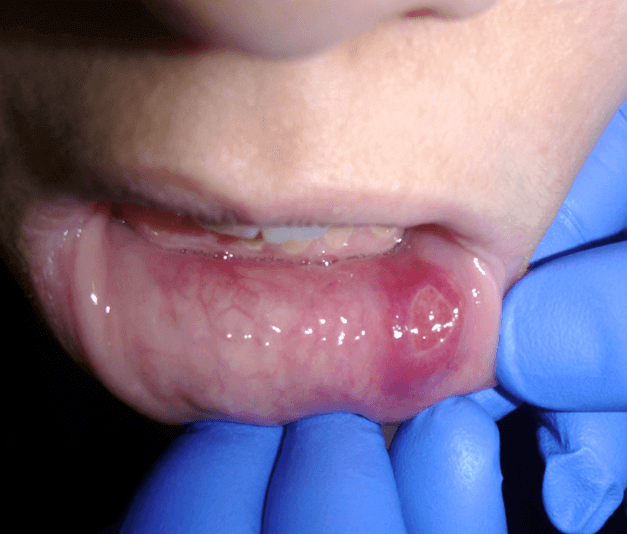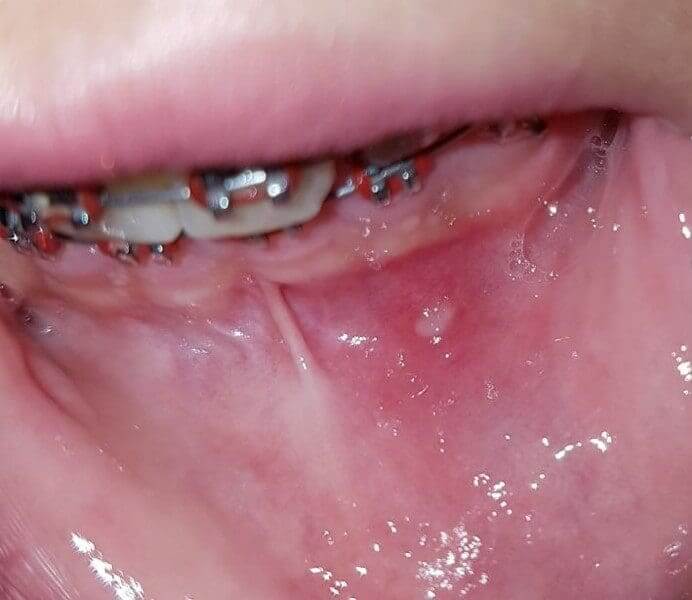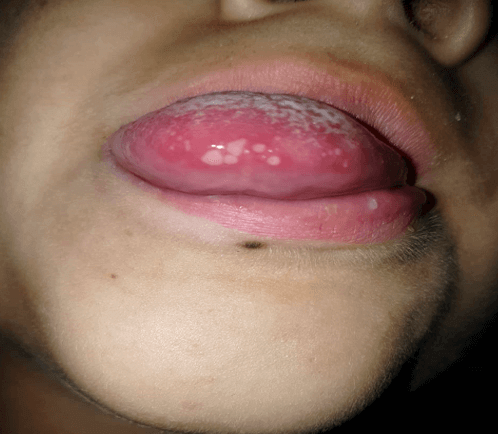
Everything you need to know about recurrent aphthous stomatitis (canker sores) in children (and adults)
Canker sores are very common in children and can be very distressing for both the children and their parents. There are several reasons behind this distress – canker sores are truly unpleasant, are often associated with viral infections such as hand-foot-and-mouth disease or herpes (both of which have quite the reputation), or may have no underlying medical explanation at all.
But first, let’s make sure we’re all on the same page. The correct medical term for canker sores is aphthous ulcers. It’s important to learn the difference between aphthous ulcers, caused by viral infections and “real” aphthous ulcers.
Aphthous ulcers that develop during viral infections are not really aphthous ulcers. They are simply small blisters in the mucosa of the mouth that burst within a short period of time leaving shallow ulcers behind. Lots of people refer to them as aphthous ulcers but they are not real aphthous ulcers. You’ll learn more about this below.
The correct medical terminology for real aphthous ulcers that recur is recurrent aphthous stomatitis. These are aphthous ulcers that tend to recur frequently and are extremely disturbing. The goal of this post is to give you all the necessary information about the diagnosis and treatment of these aphthous ulcers and to turn you into aphthous ulcer pros!
This post was written by Dr. Gal Avishai, a great specialist in oral medicine in children and adults.
What are aphthous ulcers (canker sires)?
An aphthous ulcer is a painful ulcer in the oral cavity. Aphthae are usually oval or round-shaped lesions, with a white or yellow center and a red halo surrounding them. Aphthae often develop on the inner parts of our lips or cheeks or on the sides of our tongue, or under it. Occasionally, aphthae can develop on the soft palate and on the back of the tongue. Take a look at the images attached for examples.

Do aphthous ulcers develop during viral infections such as hand-foot-and-mouth disease or herpes?
The lesions that develop during viral infections are not true aphthous ulcers. Those lesions are completely different from aphthous ulcers.
Sporadic (isolated) episodes of mouth ulcers in children are caused by viral infections. They are then followed by signs and symptoms characteristic of that same viral infection that causes the ulcers, all while more and more ulcers appear in the mouth. The most common viral infections are those caused by the enterovirus family, which you are better familiar with as hand-foot-and-mouth disease and primary herpes infections (link here). It is not very common to find ulcers caused by other pathogens in children.
Keep in mind, though, that not every single ulcer that develops in the mouth is an aphthous ulcer, even if it may look like one. In the viral infections mentioned above, the lesions that develop in the mouth look like aphthous ulcers but are not aphthous ulcers. In fact, they are thin blisters that burst quite easily within a short period of time and leave behind a shallow ulcer, typically resolving spontaneously within 7-10 days. A pediatrician or an oral specialist will be able to help with the diagnosis and appropriate treatment of such ulcers.
However, recurrent episodes of aphthous ulcers carry an extensive and important differential diagnosis, and that is what I will be focusing on for the remainder of this post.

What is recurrent aphthous stomatitis?
Recurrent aphthous stomatitis is the most common oral condition, and it manifests as recurrent episodes of single or multiple ulcers that are very painful. The time interval between one episode and the next is not always regular and may vary from several days to months. Some people even suffer from one ulcer after the other continuously, without any breaks.
What are the different types of recurrent aphthous stomatitis?
Minor aphthae – aphthae that are less than 5mm in diameter and resolve spontaneously and quickly, within several days to 2 weeks. I attached an example in the second image in this post.
Major aphthae – these are rarer, the ulcers are larger here, about 1-3cm in diameter and take several weeks to heal. These ulcers are very painful and make it very difficult for someone to go about their regular day. Check out the first image attached.
Another type of aphthae is the Herpetiform Aphthae, are a large collection of small ulcers. As their name implies, they often look very similar to herpes. Take a look at the last image attached.
Is recurrent aphthous stomatitis common?
Yes. Approximately one quarter of the population suffer from recurrent aphthous ulcers at one point or another in their life. In children, they are even more common and are found in about 40% of the population.
In most people the condition starts during childhood or adolescence, particularly ages 10-19, and tends to improve over time. Children whose parents (at least one) experience recurrent aphthous ulcers have a 90% chance of developing the condition, as opposed to 20% in those whose parents never suffer from ulcers. That means there is a genetic background to the condition.
What causes recurrent aphthous stomatitis?
The cause of recurrent aphthous stomatitis is unknown but there are several different theories. It seems like despite their similar appearance in most people, there can be different causes in different people. The medical literature has proposed several possible explanations, such as local mechanical stress (from a bite or orthodontic gear), changes in the composition of saliva, genetic factors, dietary factors (such as iron and vitamin B deficiencies or dietary intolerances) and more. However, it is important to emphasize that in most cases, the cause of recurrent aphthous stomatitis is unknown.
Also, a correlation has been found between emotional stress and an increased frequency of recurrent aphthous ulcers.
Furthermore, there are several other medical conditions that manifest in lesions that look similar to aphthous ulcers. It is important to rule such conditions out when investigating the cause of ulcers.
What kind of medical conditions manifest as recurrent aphthae in the oral cavity?
Let’s start with some reassurance – most cases of recurrent aphthous stomatitis do not have a known cause and are not associated with any underlying medical conditions. Nonetheless, it is still important to put effort into investigating the cause and attempting to find the reason behind the condition. Identifying and managing the underlying condition, if such condition is found, always leads to improvement in the patient’s wellbeing. That is why consulting a specialist who will ask the right questions, look for the relevant signs and lead the correct investigation is crucial.
What are these medical conditions that we are talking about?
PFAPA – this condition is super common. Of-course the aphthous ulcers here are only one of the signs and symptoms. Read more about PFAPA here.
Inflammatory Bowel Disease (IBD) such as Crohn’s Disease – since the oral mucosa is a part of the gastrointestinal mucosa, it can be involved in IBD just like any other part of the gastrointestinal tract.
Celiac Disease – you can read more about Celiac here.
Rheumatological diseases –kind of diseases? A rare condition called Behcet manifests as recurrent aphthous stomatitis. Another rare condition called Hyper IgD syndrome can also present as recurrent ulcers.
A severe decrease in neutrophilic blood cell count (or neutropenia) – check out this link to learn more about the components of the complete blood count.
Certain drugs – there are several medications that can cause aphthous ulcers. For example, medications belonging to the family of non-steroidal ant-inflammatory drugs such as ibuprofen, taken for fever or pain and frequently administered to children.
Rare skin disorders – sometimes skin disorders can manifest in the oral mucosa.
What about aphthous ulcers in adults?
Adults may also experience aphthous ulcers. About 80 percent of them will report having had them since childhood. Even if a person is older, it is important to investigate the cause of these ulcers. If this is recurrent aphthous stomatitis then it is important to rule out nutritional deficiencies, harmful habits, etc. At the same time, it is very important to rule out possible underlying conditions such as immunological diseases, autoimmune illnesses or pre-cancerous conditions. Take it as a rule of thumb that if an ulcer does not heal within 2 weeks, then one must seek medical help and undergo medical investigation.
What are the principles behind the management of recurrent aphthous stomatitis?
If the cause of the condition is unknown, there isn’t a specific way to prevent them from occurring. However, if an underlying medical condition is identified, then treating that underlying condition will also help prevent the recurrence of the ulcers.
Remember, most ulcers will resolve spontaneously within a few days, with or without treatment. Nonetheless, because they can be very painful, and they can limit the ability to talk, eat or maintain basic oral hygiene, some of the deeper ulcers require treatment. This is especially true when one episode of ulcers is quickly followed by another. The goal of treatment is to relieve pain, hasten healing and minimize the frequency of recurrence. We have yet to discover a single medication that is perfect for the condition. Milder situations, where the aphthae are minor (up to 5mm in diameter) and occur infrequently, are commonly treated with topical pastes or mouth wash that contains steroids and anesthetics. Maintenance of good oral hygiene is very important in such situations, as well. More complicated conditions where the ulcers are larger in size and number are commonly treated with oral steroids.
How can we treat aphthous ulcers in children? Is there a topical paste available to treat it?
Luckily, most aphthae in children are minor and very rarely do they need specific treatment. In addition to what I mentioned above about management, when it comes to children, offering treatment can become more challenging as their willingness to cooperate is sometimes limited.
In children over the age of two years, the use of a paste containing steroids and a local anesthetic (such as lidocaine and triamcinolone paste) may be helpful. Despite this paste being available over the counter, I still advise consulting with a physician prior to its use to find out more about the recommended dose and length of treatment.
No matter the underlying cause of mouth lesions, be them aphthous ulcers or other ulcers caused by viral infections, it is very important to ensure that the child does not get dehydrated as these lesions make it very difficult to eat and drink. It is important to offer the child soft foods and plenty of fluids. In certain situations, it may be beneficial to give them an analgesic (such as Tylenol) about half an hour before a meal.
As I have already mentioned above, it is super important to encourage maintenance of adequate oral hygiene. The accumulation of bacteria on teeth can worsen the ulcers and prolong the healing process. I suggest you consult with your oral doctor or child’s dentist for more tips on how to best maintain oral hygiene.
Generally speaking, appropriate treatment will be individualized to the patients after a full medical assessment, including a physical examination, a search for additional signs and symptoms, a detailed family history and a full workup. Often, bloodwork will be needed as well.
Are there any “folk remedies” that could be beneficial?
Before I answer this question, I’ll just start by saying – keep in mind that the efficacy and ability of folk remedies to reduce pain and decrease the length of disease has never been studied in scientifically reliable research. And they certainly do not prevent the development of more ulcers. Despite that, you can try applying tahini (sesame paste) on them or washing the mouth with salt water and see if it brings any relief. Herbal medicines containing plant extracts, honey or tree resins sold in pharmacies can also be helpful – just make sure these substances do not contain sugar, as the frequent use of sugar-containing substances can increase the risk of development of dental caries.
Again, as usual, it is fun being a kid when it comes to this condition. Don’t get me wrong, having recurrent aphthous stomatitis is never fun, but in children there is usually no specific cause and these episodes tend to resolve within a few days. On the other hand, in prolonged situations where they recur frequently and especially if there are accompanying symptoms, regardless of whether the patient is a child or adult it is important to see an oral specialist to discuss the best available workup and treatment for you.
For comments and questions, please register
